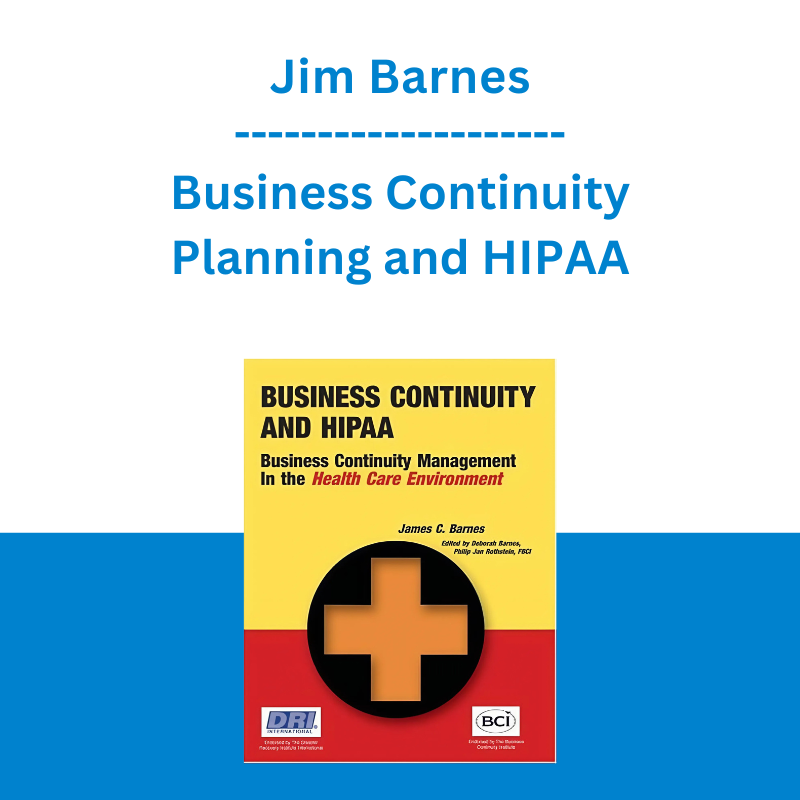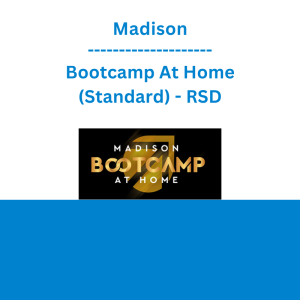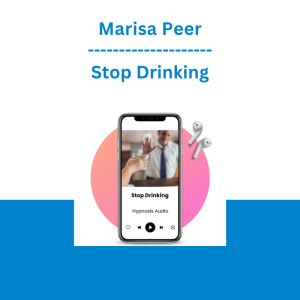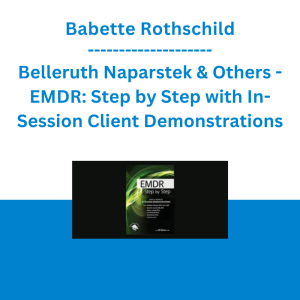*** Proof of Product ***
Exploring the Essential Features of “Jim Barnes – Business Continuity Planning and HIPAA: Business Continuity Management in the Health Care Environment”
Business Continuity Planning and HIPAA: Business Continuity Management in the Health Care Environment Paperback
by James C. Barnes (Author), Philip Jan Rothstein (Editor), Deborah Barnes (Editor)
This book examines business continuity planning as adapted to encompass the requirements of The Health Care Portability and Accountability Act of 1996, or HIPAA. We examine the typical business continuity planning model and highlight how the special requirements of HIPAA have shifted the emphasis. The layout of this book was designed to afford assistance, hints, and templates to the person charged with the task of implementing business continuity planning into a healthcare organization.You will notice that this book does not address Emergency Management (building evacuations and other immediate response procedures) because this is outside the scope of the HIPAA regulations.
Upon reading and re-reading the HIPAA regulations and the “Comments and Responses” in the federal register, it becomes quite evident that the “Contingency Plan” (read Business Continuity Plan) requirements were written by those looking to protect health information data. That being said, many of the examples that I use in this book relate to information technology and disaster recovery (recovery of computer capabili-ties). What is also important, and that I try to emphasize throughout the book, is that recovering the com-puter systems of a health care organization will not necessarily get it operational again after a disaster; a multitude of other production components must be present in order to deliver services and products to customers/patients. Where appropriate, I have identified procedures and strategies that are unique to healthcare provider organizations. If not so indicated, it can be assumed that I am referring to healthcare organizations in general.
The audience for whom I have designed this book are the people who are responsible for implementing a plan in a healthcare organization that comes under the scope of the HIPAA regulations. At first reading, the book may appear to be an exact template to be used to design a business continuity plan. What I hope that you will get out of the book (perhaps on a reread once you are into the planning project) is that this is a pencil outline on a canvas and that your insights and knowledge of your healthcare organization will add the color that will make it a masterpiece.
What you will notice in this book is that we present an approach that is similar to traditional business continuity planning. This is done purposefully. The basic business continuity planning model looks to protect and/or recover all critical components of production. This model assumes an industry-specific nature not by changing the model itself, but by placing greater emphasis on the protection and recovery of those production resources that characterize that industry. In our view, “thinking outside the box” is only required if the box was ill-conceived in the first place.
This book includes the special precautions and procedures that address the unique concerns of HIPAA, but it will present them along with the other business components in order to emphasis the need to take a holistic approach when constructing and maintaining a business continuity plan.
Editorial Reviews
Review
“‘must read’ for all business continuity practitioners in the healthcare field… Thorough research, clear guidelines… a wealth of templates, samples.” — Endorsed by The Business Continuity Institute (BCI)
“…helps healthcare professionals crystallize ways companies comply with HIPAA. structured approach, easy to follow, conforms to best practices and standards.” — Endorsed by Disaster Recovery Institute International (DRII)
From the Inside Flap
“On August 21, 1996 the Health Insurance Portability & Accountability Act (HIPAA) became a law. The purpose of this act is to provide US citizens with better access to health insurance, limit fraud, and reduce healthcare companies’ administrative costs. At the highest level, HIPAA is a set of government-mandated standards for business to business healthcare e-commerce. It mandates standard electronic transactions with standard code sets using standard identifiers in a secure environment.”HIPAA is the result of the convergence of healthcare cost pressures, available web technologies, and growing demands by consumers. By enacting this legislation, congress has established a standard basis or framework for the healthcare industry to embrace the economies of e-business.
“Within HIPAA are five primary components identified as Titles I, II, III, IV, and V. Title II, or Administrative Simplification, is the component of HIPAA containing, among other elements, the requirement for business continuity planning. The breakdown of the HIPAA components is as follows:
– Title I guarantees health insurance access, portability, and renewal. It eliminates some pre-existing condition exclusions. It prohibits discrimination based on heath status. It guarantees coverage renewal.
– Title II prevents health care fraud and abuse, promoting administrative simplification. Within Title II are fraud and abuse controls, procedures for administrative simplification, and medical liability reform.
– Title III addresses medical savings accounts and health insurance tax deductions for self-employed individuals.
– Title IV provides for the enforcement of group health plan provisions.
– Title V addresses revenue offset provisions.
What has caused HIPAA to occur at this point in time? In 1991, it was estimated that one quarter of the total cost of healthcare was attributable to the cost of administration.
In 1995, over 5 billion claims a year were filed in the US with less than 20% submitted electronically. Over 400 different formats are used to file electronic claims. By streamlining this process, it is estimated that $9 billion annually could be saved without impacting the quality of care. The time had come when these economic forces could not be ignored.
HIPAA is the most sweeping legislation to affect the health care industry in over 30 years. It is anticipated that large health plans will have to spend $50 to $200 million to become HIPAA compliant. Nearly everyone in healthcare will need to comply: payers, employers, providers, clearinghouses, healthcare information systems vendors, billing agents, and service healthcare organizations.
Who is affected? The answer is health plans, providers, health care clearing houses, and some others. Health plans include individual or group plans that provide or pay the cost of medical care. It also includes employers who self-insure. Providers include a provider of medical or other health services and any other person furnishing health care services or supplies. Health care clearing houses are public or private entities that process or facilitate the processing of nonstandard data elements of health information into standard data elements. Finally, the “other” category which includes employers who want to do data mining and pharmaceutical companies that conduct clinical research.”
About the Author
JIM BARNES received an early introduction to check-listed emergency operating procedures as a commander of an ICBM launch crew in the Air Force’s Strategic Air Command. While in the Air Force, Jim received a Master’s degree in Economics which led him into being a bank economist when he left the service. This economics and financial background have forged a view of business continuity planning that is more business than technically oriented.Jim has over 15 years of extensive experience in Business Continuity Planning. He was in charge of designing Business Continuity Planning software which was marketed and used internationally. Most recently, Jim assisted in the design of a Business Continuity Certification course which he taught to “Big Four” consultants in Europe, South America, and the United States. Jim has written over 300 Business Continuity Plans most of which were for Health Services “Payer” institutions and for Financial Institutions. Jim has completed and has published, “A Guide to Business Continuity Planning”, “E-Commerce Security-Business Continuity Planning: A Technical Reference Guide”, and has written “The Linchpin to Successful Business Continuity Planning” in the Fall, 2003 Disaster Recovery Journal.
Jim is the founder and CEO of Barnes Continuity Planners, Inc. (BCP, Inc), a consulting firm that assists client companies with in business continuity planning. BCP, Inc. specializes in creating recovery plans, recovery strategies, and institutionalizing continuity management within an organization’s culture. Jim is a Certified Recovery Planner and a Member of the Business Continuity Institute.
Product details
Publisher : Rothstein Associates Inc.
Language : English
Paperback : 240 pages
About the author
James C. Barnes
Authored 3 books on business continuity planning (under James C Barnes) and wrote 3 articles for Disaster Recovery Journal. Worked as a consultant(Deloitte, PricewaterhouseCoopers, Sungard) and head of large corporate business continuity departments(First American Title, Citibank, Florida, CNA).
Was a Captain in the US Air Force from 1967 to 1973. Was Minuteman Combat Crew Commander in Strategic Air Command. In the service I receive a Masters Degree in Economics. Became a bank economist which morphed into operational and strategic planning for banks. Worked for the above consulting firms first as a strategic planner and then as a designer of business continuity plans. Created over 100 plans, 7 of which were successfully exercised during disaster situations. IBM has distributed my book when discussing Disaster Recovery Planning with clients.
Customer reviews
Steven Lewis
HIPAA unscrambled
HIPAA has become the latest industry bugaboo……..so many vendors are advertising that “HIPAA requires this or that…” it is very confusing to understand what is for real and what is just vendor hype. This book provides an unbiased assesment of what the regulations are looking for, as well as “best practices” approaches to satisfying them.
J. Williams
Great reference manual to implement HIPAA
This book gives an excellent framework to complete the entire HIPAA Business Continuity / Contingency Planning implementation, from beginning to end.
Please see the full list of alternative group-buy courses available here: https://lunacourse.com/shop/










 Lois Fenner - Legal and Ethical Issues in Behavioral Health in Mississippi - PESI
Lois Fenner - Legal and Ethical Issues in Behavioral Health in Mississippi - PESI  Brian Wood - Adobe Illustrator CC for Beginners
Brian Wood - Adobe Illustrator CC for Beginners  Lois A. Fenner-McBride - Elder Law: Advanced Care Planning, Elder Abuse & Professional Malpractice
Lois A. Fenner-McBride - Elder Law: Advanced Care Planning, Elder Abuse & Professional Malpractice  Hahna Kane Latonick - Freelance Developer Jumpstart
Hahna Kane Latonick - Freelance Developer Jumpstart  Melinda Chung - Product Marketing Resume Boost
Melinda Chung - Product Marketing Resume Boost  Julie Stoian & Cathy Olson - Launch Gorgeous - Funnel Gorgeous Bundle
Julie Stoian & Cathy Olson - Launch Gorgeous - Funnel Gorgeous Bundle  Messenger Marketing Secrets For Business Domination (2019)
Messenger Marketing Secrets For Business Domination (2019)  Kendall SummerHawk - Sacred Money Archetypes Training Program
Kendall SummerHawk - Sacred Money Archetypes Training Program  Martin Antony - Cognitive-Behavioral Therapy for Perfectionism Over Time
Martin Antony - Cognitive-Behavioral Therapy for Perfectionism Over Time  Firas Zahabi - Strong and Stable Knees 4 Life
Firas Zahabi - Strong and Stable Knees 4 Life  Madison Bootcamp At Home (Standard) - RSD
Madison Bootcamp At Home (Standard) - RSD  Sabine Stanley - A Field Guide to the Planets
Sabine Stanley - A Field Guide to the Planets  Raghee - New Day Trading Playbook BASIC -Simpler Trading
Raghee - New Day Trading Playbook BASIC -Simpler Trading  Atlas API Training - API 570 Exam Prep Training Course
Atlas API Training - API 570 Exam Prep Training Course  Jeffery Long - Indian Philosophy: Paths and Worldviews - Collection
Jeffery Long - Indian Philosophy: Paths and Worldviews - Collection  Marisa Peer - Stop Drinking
Marisa Peer - Stop Drinking  Team NFT Money - Ultimate NFT Playbook
Team NFT Money - Ultimate NFT Playbook  Danielle Shay - Ready Aim Freedom: High Probability Directional Options Strategy for Small Accounts E-Learning Module - Simpler Trading
Danielle Shay - Ready Aim Freedom: High Probability Directional Options Strategy for Small Accounts E-Learning Module - Simpler Trading  Paul Murphy - The Affiliate Tube Success Academy 2022
Paul Murphy - The Affiliate Tube Success Academy 2022  The Development of European Civilization -Kenneth Bartlett
The Development of European Civilization -Kenneth Bartlett  Mina Irfan - Femm Container Course - The Universe Guru
Mina Irfan - Femm Container Course - The Universe Guru  Vesica - True Rosicrucian Course 3 - Sacred Geometry of the Rosicrucians
Vesica - True Rosicrucian Course 3 - Sacred Geometry of the Rosicrucians  Iowa Legal and Ethical Issues for Mental Health Clinicians - Susan Lewis - PESI
Iowa Legal and Ethical Issues for Mental Health Clinicians - Susan Lewis - PESI  Peggy Lamb - Manual Therapy for the Piriformis & Quadratus Lumborum: Practical Solutions to Back and Sciatic Pain - PESI
Peggy Lamb - Manual Therapy for the Piriformis & Quadratus Lumborum: Practical Solutions to Back and Sciatic Pain - PESI  Greg Loehr - Advanced Option Trading With Broken Wing Butterflies
Greg Loehr - Advanced Option Trading With Broken Wing Butterflies  Sedona Method - Effortless Creation
Sedona Method - Effortless Creation  Ready2Go Marketing Solutions - Say It! Hear It! - Workshop
Ready2Go Marketing Solutions - Say It! Hear It! - Workshop  Jason Hoppe - Intro to Adobe Illustrator
Jason Hoppe - Intro to Adobe Illustrator  How to Create and Deliver an Impactful Presentation - Matt Stevenson
How to Create and Deliver an Impactful Presentation - Matt Stevenson  Positive Publishing - Mindfulness and You
Positive Publishing - Mindfulness and You  Edwin Lefevre - Wall Street Stories
Edwin Lefevre - Wall Street Stories  Dave Landry - Stock Selection Course
Dave Landry - Stock Selection Course  Jay Earley & Bonnie Weiss - Transforming Perfectionism Course
Jay Earley & Bonnie Weiss - Transforming Perfectionism Course  Janina Fisher - Chronic Pain & Trauma
Janina Fisher - Chronic Pain & Trauma  Jonathan Jordan - Animal-Assisted Interventions: An Incredible Range of Therapeutic Benefits - PESI
Jonathan Jordan - Animal-Assisted Interventions: An Incredible Range of Therapeutic Benefits - PESI  SMB - Options Training
SMB - Options Training  Daysha Veronica (Edewi) - Understanding Viral Content
Daysha Veronica (Edewi) - Understanding Viral Content  John Overdurf & Julie Silverthorn - Patterns of Integration
John Overdurf & Julie Silverthorn - Patterns of Integration  WhoisMatt LUTs - Matt Johnson
WhoisMatt LUTs - Matt Johnson  Special Package (SC - Courses + eBooks)
Special Package (SC - Courses + eBooks)  Elad Elrom - The Blockchain Developer
Elad Elrom - The Blockchain Developer  Simpler Trading - Bruce Marshall - The Options Defense Course
Simpler Trading - Bruce Marshall - The Options Defense Course  Cory Mitchell - Forex Strategies Guide for Day and Swing Traders - Vantage Point Trading
Cory Mitchell - Forex Strategies Guide for Day and Swing Traders - Vantage Point Trading  Babette Rothschild, Belleruth Naparstek & Others - EMDR: Step by Step with In-Session Client Demonstrations
Babette Rothschild, Belleruth Naparstek & Others - EMDR: Step by Step with In-Session Client Demonstrations  Chris Capre - Advanced Price Action Ongoing Training & Webinars
Chris Capre - Advanced Price Action Ongoing Training & Webinars